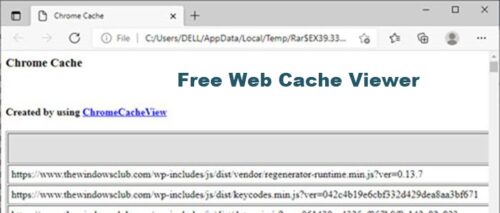Access to cache files may be needed at times for missing files. If you are looking for a cache viewer tool for viewing cache files on Google Chrome, Mozilla Firefox, and Microsoft Edge, then there are two useful utilities, namely ChromeCacheView and MZCacheView.
The developer has developed different cache viewer apps for different browsers such as Chrome, Edge, and Mozilla Firefox. Let us look at how to download this utility and use it to read cache files.
Free cache viewer for Chrome and Edge
NirSoft has developed a free cache viewer for Chrome and has named it ChromeCacheView. It’s a simple utility that lets you read the cache files on Chrome.
How to download and use ChromeCacheView
ChromeCacheView, the free cache viewer for Chrome doesn’t require any installation. Follow the next steps to access the cache files on the Google Chrome browser:
1] Download the zipped file from the official link.
2] Open the folder.
3] Open the .exe file. It immediately reads all the cache files from the browser and displays the list of all files currently stored in the cache as follows:
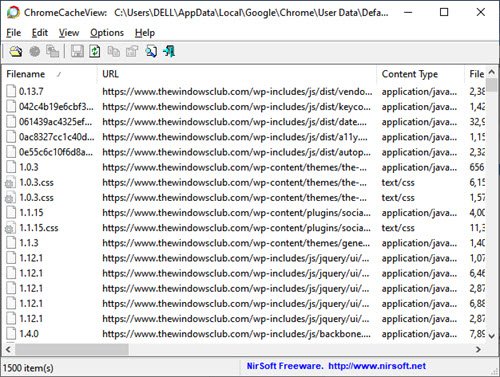
The cache folder of Google Chrome is located under the following path:
[User Profile]\Local Settings\Application Data\Google\Chrome\User Data\Default\Cache
4] For each cache file, the following information is displayed:
- File name
- URL
- Content type
- File size
- Last accessed time
- Expiration time
- Server name
- Server response
- Website
- and more
5] You can easily select one or more items from the cache list, and then extract the files to another folder, or copy the URLs list to the clipboard. Simply right-click on the file and you can see several options. You can:
- Save selected cache files
- Copy selected cache files
- Open selected cache files
- Get HTML report for the selected or all cache files
- Choose columns of the displayed results
- Auto size columns
- See Properties of the selected cache file
- Refresh the results
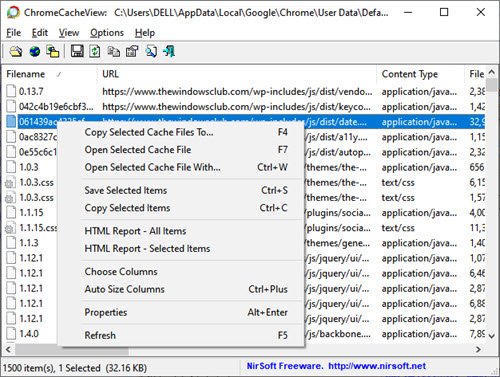
HTML Report:
This option in ChromeCacheView, the free cache viewer for Chrome, generates an HTML report of the cache files. You can get this report for all cache files or only for the selected files. It is basically the same cache files report, only generated in the form of an HTML page.
Choose Columns:
This option lets you change the column settings. You can choose and reorder the columns to be displayed in the results. To do so, right-click on any cache file displayed in the results. Click on Choose Columns. A window containing all column names appears. You can check the columns you wish to see in the results. You can also use the Hide and Show buttons to uncheck or check columns respectively. You can also move the columns up and down using the Move Up and Move Down buttons respectively. For each column, you can change the width by entering a value in the Width of selected column (in pixels). Click OK to apply the changes.
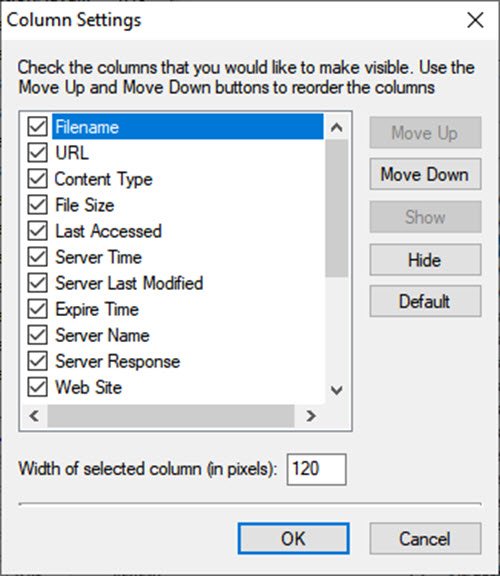
Properties:
When you click on this option in the menu, you can see all the properties of the selected cache file on the browser.
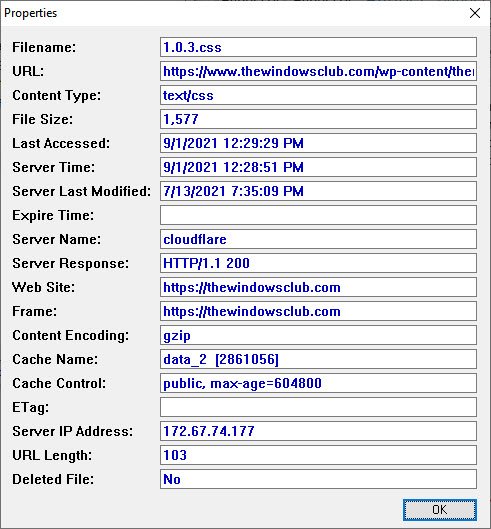
Free cache viewer for Mozilla Firefox
Similar to ChromeCacheView, the developers of this utility have developed MZCacheView, a free cache viewer for Mozilla Firefox. It reads the cache folder of Firefox/Mozilla/Netscape Web browsers and displays the list of all files currently stored in the cache.
How to download and use MZCacheView
Just like ChromeCacheView, MZCacheView doesn’t require any installation. Follow the next steps to access the cache files on the Mozilla Firefox browser:
1] Download the zipped file from the official link.
2] Open the folder.
3] Open the .exe file. It immediately reads all the cache files from the browser and displays the list of all files currently stored in the cache. For each cache file, the following information is displayed:
- Filename
- URL
- Content type
- File size
- Last modified time
- Last fetched time
- Expiration time
- Fetch count
- Server name
- and more.
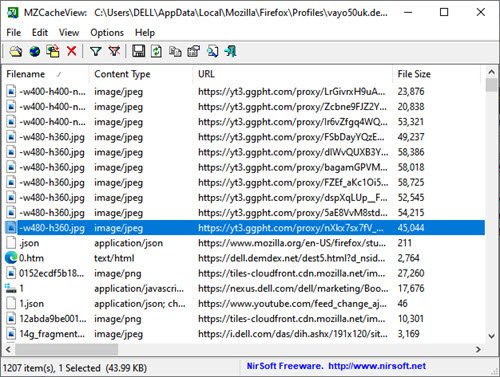
The cache folder of Mozilla Firefox is located under
C:\Documents and Settings\[User Name]\Local Settings\Application Data\Mozilla\Firefox\Profiles\[Profile Name]\Cache
Note: To view the latest cache files, close all Firefox tabs. Only then Firefox saves the cache index files into the disk.
4] Using the right-click menu, you can easily select one or more items from the cache list, and then extract the files to another folder, or copy the URLs list to the clipboard. Just like ChromeCacheView, right-click on the file and you can see several options. You can:
- Save selected cache files
- Copy selected cache files
- Copy Full Response Header
- Copy clicked cell
- Open selected cache files
- Open link in web browser
- Choose columns of the displayed results
- Auto size columns
- See Properties of the selected cache file
- Refresh the results
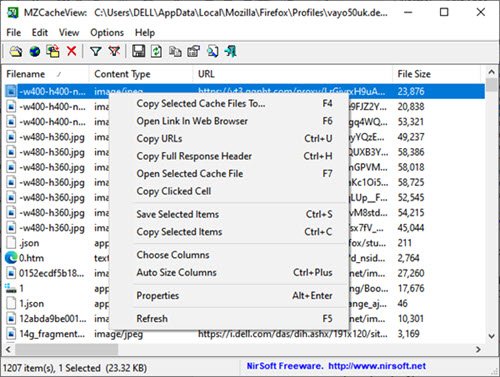
Choose Columns and Properties:
These two options in MZCacheView are the same as the same in ChromeCacheView utility. Hence, please refer to Choose Columns and Properties sections in the same article.
Missing File column:
Unlike ChromeCacheView utility, MZCacheView has an additional column named Missing File. When you delete files from the cache, MZCacheView deletes the cache files, but it doesn’t delete the reference to them in the cache index file. This means that even after you delete files from the cache, you’ll still see them in the list, but the ‘Missing File’ column will be turned from ‘No’ to ‘Yes’.
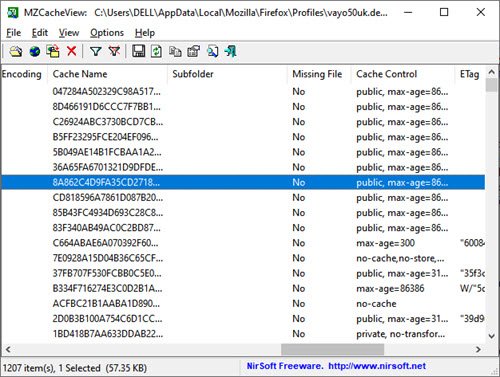
Our take on these utilities
Both cache viewer utilities are easy to use and hassle-free. Give it a try and let us know your views in the same.
Why is cache important?
Data caching plays an important role in the proper functioning of laptops, desktops, and even mobile devices. The cached data helps speed up the application performance and increase efficiency. Cache files store the data locally. As a result, browsers and websites load faster. That’s because the access elements like the homepage, images, and so on are already been downloaded.
Is it safe to delete cache files from the browser?
It is absolutely safe to delete cache files on the browser. The cached files are temporary files that save downloading time of websites and browsers in the future. For example, when a website opens, the browser downloads the home page elements such as images, logos, and files, and saves them in a cache folder. Cached data includes files, images, videos, scripts, and other multimedia.
